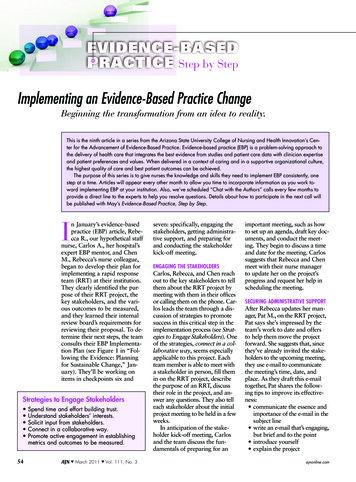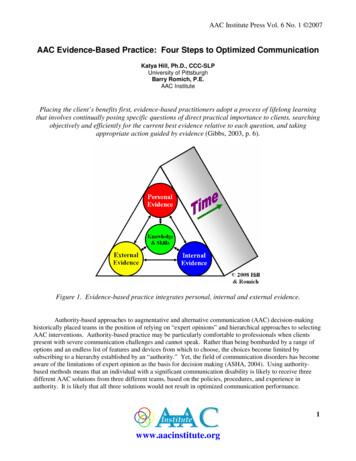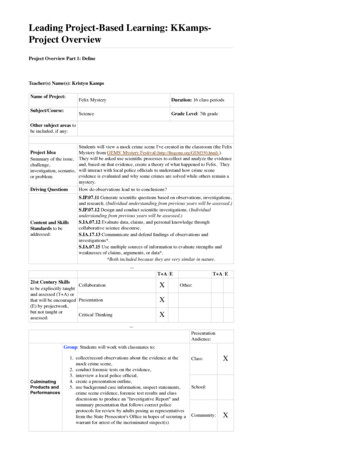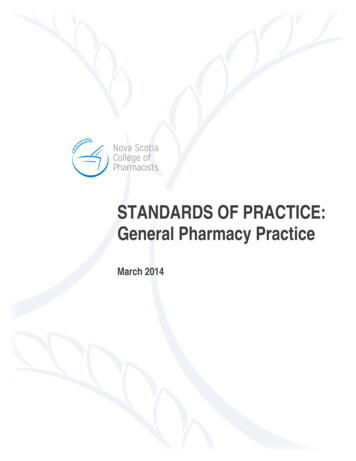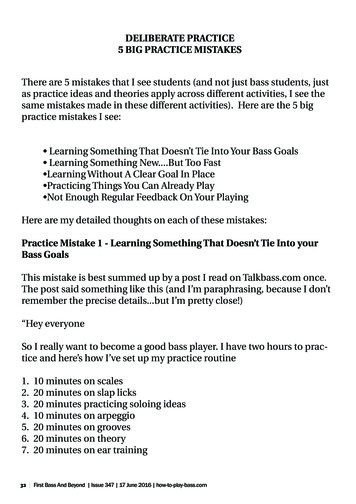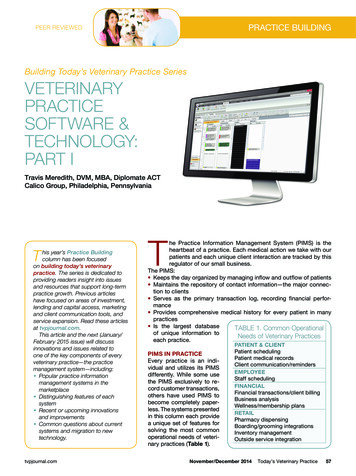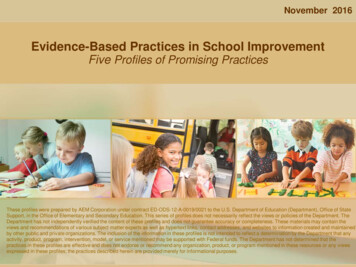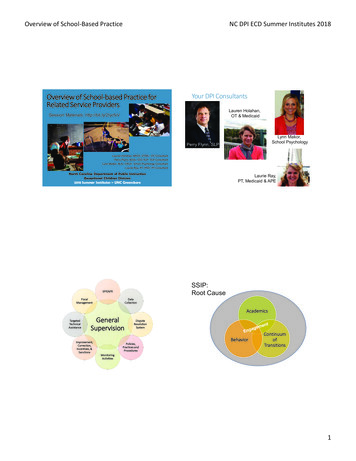
Transcription
Overview of School-Based PracticeNC DPI ECD Summer Institutes 2018Overview of School--based Practice forRelated Service ProvidersYour DPI ConsultantsLauren Holahan,OT & MedicaidSession Materials: http://bit.ly/2IycfxVLynn Makor,School PsychologyPerry Flynn, SLPLauren Holahan, MSOT, OTR/L- OT ConsultantPerry Flynn, M.Ed., CCC-SLP- SLP ConsultantLynn Makor, M.A., CAGS- School Psychology ConsultantLaurie Ray, PT, PhD- PT ConsultantNorth Carolina Department of Public InstructionExceptional Children Division2018 Summer Institutes – UNC GreensboroLaurie Ray,PT, Medicaid & APESSIP:Root ovement,Correction,Incentives, Practices ities1
Overview of School-Based PracticeTopics for Today: NC DPI ECD Summer Institutes 2018Setting MattersEducational & Clinical Service ModelsLeast Restrictive EnvironmentEvidenced-based ProcessCurriculum-based ProcessParent Consent & PartnershipIntegrated IEP DevelopmentEmbedded InterventionData-based Practice/ Progress MonitoringEthicsRosters, Schedules & WorkloadAnswering Your QuestionsEducational & Clinical Models:Similarities and DifferencesPrivate Practice v. Public School PracticePrivate evaluations are often conducted for the purposes of diagnosingconditions, gaining insight, pursuing medical intervention, etc.Formal evaluations within the public school arena are only conductedwhen a child is suspected to have a disability under IDEAeligible in 1(or more) of 14 areas of eligibility adverse effect on educational performance need for specially designed instruction disability under IDEA2
Overview of School-Based PracticeNC DPI ECD Summer Institutes 2018It Is Not an Either/Or Situation:IDEA 2004: Related ServicesSome children should receive servicesthrough both models.oFor many children the frequency or intensity of therapy theyreceive at school through the educational model will not meet allof the child's needs for therapyoThere may be goals that are not addressed by school basedtherapy and would require home or community based servicesfrom the medical modeloIn each setting, the child should be assessed individually todetermine the best way to meet his or her needs transportation, and such developmental, corrective, and othersupportive services (including speech-language pathology andaudiology services, interpreting services, psychological services,physical and occupational therapy, recreation, includingtherapeutic recreation, social work services, school nurse servicesdesigned to enable a child with a disability to receive a freeappropriate public education as described in the individualizededucation program of the child, counseling services, includingrehabilitation counseling, orientation and mobility services, andmedical services, except that such medical services shall be fordiagnostic and evaluation purposes only) as may be required toassist a child with a disability to benefit from special education, andincludes the early identification and assessment of disablingconditions in children.Special ScopeIDEA 2004: Related ServicesAny service a student with a disability requires in order tobenefit from his/her special education program:Educationallyrelevant IEPS &interventionsProblemsolvinglimitationsat schooly “Meet their unique needs”y achieve their IEP goals and/ory access and participate in the educational environmenty “Prepare them for further education, employment andindependent living.”y Service must be related to an educational need or function34 CFR alistintervention plansand servicedocumentation( Participation & educational performance are primary in educationalpracticeInternational Classification of Functioning,Disability, and Health (ICF), WHO, 20013
Overview of School-Based PracticeNC DPI ECD Summer Institutes 2018Specially Designed Interventions4.5 To address gaps and/or accelerateacademic, behavioral, andfunctional progress toward ageand grade-level standards To help students with disabilitiesgraduate with a diploma To make all school programs,activities, and environmentsaccessible To attain IEP goalsRole of Related Service Providers (RSPs)43.5Grade Level To ensure a free, appropriate,public education (FAPE)Accelerating Growth for Students withDisabilities32.521.511st Quarter2nd Quarter3rd Quarter4th QuarterWhat about School Psychological Services? Collector of information Provider of information Active participant at IEP meeting Share information prior to meeting if unable to attend Synthesizer of information From unique perspective of PT expertise In light of developmental prioritiesritiesALL Education Team Player4
Overview of School-Based PracticeNC DPI ECD Summer Institutes 2018Psychological Services include:Counseling as a Related Service:(i) Administering psychological and educational tests, and otherassessment procedures;(ii) Interpreting assessment results;(iii) Obtaining, integrating, and interpreting information about childbehavior and conditions relating to learning;(iv) Consulting with other staff members in planning school programs tomeet the special educational needs of children as indicated bypsychological tests, interviews, direct observation, and behavioralevaluations;(v) Planning and managing a program of psychological services, includingpsychological counseling for children and parents; and(vi) Assisting in developing positive behavioral intervention strategies.Services provided by qualified social workers,psychologists, guidance counselors, or other qualifiedpersonnel.Federal Register /Vol. 71, No. 156 /Monday, August 14, 2006 /Rules and Regulations (pg. 46760)Federal Register /Vol. 71, No. 156 /Monday, August 14, 2006 /Rules and Regulations (pg. 46761)Evidence-based Practice in SchoolsEvidence-based Practice ResourcesWhat Works Clearinghouse - http://ies.ed.gov/ncee/wwc/ Work within parameters offoundational documents Use EBP models/processes Use standardized assessments Use interventions likely tochange target behavior ifimplemented with integrity Record, interpret, &recommend based on dataEvidence Based Intervention Network - http://ebi.missouri.edu/Common Core &EssentialStandardsProfessionalScope ofPracticeIDEA/NCPolicyAOTA - http://www.aota.org/ebpAPTA - http://www.apta.org/evidenceresearch/Hooked on EvidenceOpen Door: APTA's Portal to Evidence-based PracticePTNowASHA - http://www.asha.org/members/ebp/SAMHSA - National Registry of Evidence-Based Programs andPractices www.nrepp.samhsa.govEBP in schools Curriculum-based practice5
Overview of School-Based PracticeNC DPI ECD Summer Institutes 2018Parent Consent Special education 504 Plans FERPA Medicaid Communication outside of school E-mailThe TherapyProcess in Schools:EVALUATIONChild FindRequest may be verbal or in writing (GET IT IN WRITING)Sources of referral- those who may request that a student beevaluated:¾ School-based intervention teams(MTSS problem-solving teams, etc.)¾ Parent or family member¾ Teacher¾ Community provider90-Day TimelineIn North Carolina, schools have 90 calendar days to complete theentire process from initial referral to placementChild EPCompleteplacement90 Calendar Days6
Overview of School-Based PracticeNC DPI ECD Summer Institutes 2018Educationally Relevant Evaluation Questions What does this student need to access, participate and makeprogress in the general education curriculum? What supports this student’s performance? What limits this student’s performance? What does this student need to: access the classroom and campus? participate in extracurricular & nonacademicactivities? learn and participate with nondisabled children? achieve his/her IEP goals?The buffet is open NOT: “Does this student needtherapy or counseling at school?”Educationally Relevant EvaluationShould provide IEP team with informationfrom your professional lensShould inform decisions about: Present Level of Academic and FunctionalPerformance Access to Common Core & Essential Standards Student Goals Services Accommodations and Modifications Least Restrictive EnvironmentEducationally Relevant Data SourcesEducationally Relevant Data Sources Progress monitoringdata Questionnaires Observation notes Standardizedassessments Adaptive anddevelopmental scales Report cards Clinical judgment Play-based assessment Behavior checklists Interviews Student work samples AttendanceInterviewReview student work samplesgradeshealth recordsprevious tests/reportsoffice referralsother discipline dataattendance recordsObserve learning environment student in specific, relevantsettings (when problem ismost likely/least likely tooccur) informal observation systematic observation Testteachersparentscounselorsadministratorsthe studentothers involved in thestudent’s education universal screening curriculum-basedmeasures (CBM) districtwide and state tests diagnostic assessments functional behaviorassessments standardized assessments7
Overview of School-Based PracticeSelecting Standardized Assessments Where in the process does the assessment fit? Does the assessment address the referral concerns? Does it fit your theoretical approach? What area of the ICF model does it assess? What existing data needs further clarification, quantification, orcomparison to other children? What will the results provide that observation and work samplescan’t? Why do you want the assessment’s particular results: Will results help the team decide if this is a child with a disability? Will results guide IEP development?NC DPI ECD Summer Institutes 2018Interpretation and Assessmentmake the connection!These data mean Compared to other students in this setting Compared to other students this age This student’s disability results in This student struggles in general education because This student has success in general education when Given , this student could High expectations for this student include Adapted from OT Practice, 5/28/07 by Lorch and Herge, pp.17-22The TherapyProcess in Schools:ELIGIBILTYDETERMINATION8
Overview of School-Based PracticeNC DPI ECD Summer Institutes 2018learningconsultant,schoolpsychologist,social worker,SLP, OT, PTPerson able tointerpretstandardizedtests &instructionalimplicationsSpecialStudent if14 or older/ifappropriateParents eGeneralEducationTeacherAny one elsethe teamrequestsDetermination of Eligibility for SpecialEducation & Related ServicesDetermination of EligibilityGeneral: Upon completion of the administration ofassessments and other evaluation measures—(1) A group of qualified professionals and the parent determineswhether the child is a child with a disability as defined in NC1500-2.4, in accordance with paragraph (b) of this section and theeducational needs of the child; and(2) The LEA provides a copy of the evaluation report and thedocumentation of determination of eligibility at no cost to theparent.Three Prongs:A student is eligible to receive special education and relatedservices, IF the following three questions are addressed andanswered YES by the IEP team 1. Is this student is a ‘student with a disability’? Does the child meeteligibility criteria for the specific area of disability? Do any of the 14educational categories of disabilities fit?)2. Does the disability have an adverse effect on this student’sacademic or functional performance?3. Are these performance deficits related to the disability suchthat the student requires specially designed instruction inorder to access the general curriculum?NC 1503-2.7 – part A9
Overview of School-Based PracticeDetermination of EligibilityAll IEP team decisions are data-based; reliant on documentedinformation that has been carefully considered After the IEP team answers questions related to:NC DPI ECD Summer Institutes 2018Evaluation Purpose(s)Synthesize/Summarize Data Sources-disability criteria (prong 1)-adverse effect (prong 2)-need for specially designed instruction (prong 3)The team must also respond to the following (discussed prior toevaluation):Educational Decisions (Eligibility)9 The determination is NOT a result of lack of instruction in reading9 The determination is NOT a result of lack of instruction in math9 The determination is NOT the result of being a student who has LimitedEnglish ProficiencyEducational Planning (Design of EffectiveInstruction)) If all answers are YES, then eligibility for special education services hasbeen determined.)If any of the answers are NO, then eligibility for special education servicesis not determinedSpecial education evaluations are acontinuation of the problem solving processnot the end goal.Regardless of IDEA eligibility statusSearch for Effective EstablisheddBaselineDataMeaningfulIEP Goals10
Overview of School-Based PracticeNC DPI ECD Summer Institutes 2018Rehabilitation Act of 1973, Section 504(29 USC § 794 and 34 CFR § 104.4)"No qualified handicapped individual shall, solely by reason of hishandicap, be excluded from participation in, be denied benefits of,or otherwise be subjected to discrimination under any program oractivity which receives or benefits from Federal financialassistance."Section 504: Guiding QuestionsAll Students Authoritative agency Office of Civil Rights in the U.S. Department ofEducation Offers protection for citizens with disabilities against discrimination Requires entities receiving federal funding to afford equal access Intended to ‘level playing field’ May include accommodations and/or related services No age limitationsSection 504Type oflegislationFundingEducation Act: EntitlementSchool funding(no separate funding)State-federal-local fundingSpecial Ed Director504 Plan – accommodations &servicesIEP – Special education & related servicesDisabilitySubstantial physical/mentalimpairments14 federal categoriesParentsShould be involved; on teamConsent required; on teamNotify parentsParent consent & notice required forevaluations & placementService toolProceduralSafeguardsRequirementsEligibilityy Child findEvaluation with team decision adversely affects major life activityProtected by 504Studentseligible forIDEA Do they have equal access whencompared to other students? What accommodations and/orservices are required to ensure equalaccess? Are these accommodations and/orservices reasonableIDEACivil rights Act: DiscriminationProtectionAdministration Section 504 CoordinatorStudents w/disabilities Does this student have a physical ormental impairment that limits majorlife activities?y LREy Annual reviewThe TherapyProcess in Schools:IEP DEVELOPMENT andINTERVENTION PLANNINGEvaluation with team decision by specific category substantially limits academic & functionalperformance11
Overview of School-Based PracticeNC DPI ECD Summer Institutes 2018IEP Development: The SequenceEligibility for Special Education is determined(all 3 prongs)Present Level of Performance is determined from existing,relevant dataPrioritized Goals are written for this student at thisschool with this team for this IEP time frameMethod of progress monitoring is determinedLeast Restrictive Environment is determinedRequired services and supports areselected to achieve student goalsIntensity of services isestablishedExit is discussedEffective IEP Meetings Put yourself in the parents’ shoes Ask questions Be courteous: cell phones off and away Speak in an engaged, but not patronizing, way Be aware of the non-verbal cues of all participants (thismeans you!) Avoid professional or EC jargon Take 3 minutes Listen, actively https://www.youtube.com/watch?v Pu4KnwNu1Rw https://www.youtube.com/watch?v d44wPE9azXkEffective IEP meetings: Use an AgendaWhat role can the student play? Welcome, introductions, purpose Agenda review Ground rules, including decision-making process Present level/progress report Goals & objectives Accommodations & modifications Placement/LRE Services Adjourn12
Overview of School-Based PracticeNC DPI ECD Summer Institutes 2018IEP Development: Goals Drive ServicesIEP Development: Goals Focus on school function and participation—NOT impairments Flow out of Present Level of Performance (get specific!)Determining need for service prior to goaldevelopment results in: Factors or criterion for measuring student performance Fragmented programming Can be achieved within IEP time frame Duplication of services & supports Connect to the Common Core and Essential Standards Overlooked areas of need Undue focus on isolated skillsUnderstandableIEP GOALSRelatedServices Limited focus on participation in educationalprogram Confusion between clinical & educationalmodels of practiceSupplementaryAids & ServicesRealisticLeast Restrictive Environment (LRE)What Do We Want?“To promote academic success and socialparticipation and to access, progress, and participatein the general curriculum”(Wolfe & Hall, 2003)13
Overview of School-Based PracticeNC DPI ECD Summer Institutes 2018Based on desired outcomes for:Continuum of LRE(School-Age Students)Based on desired outcomes for: Learning Classroom skills Play skills Sports participation Social participation Self-help skills Mobility Social-emotional learning Prevocational & transitionneedsGeneral EducationIncluding CORE, supplementaland intensive interventionx CEISSpecial Education:x 50440-79% of school dayx Consultationspent with peersx Screeningwithout disabilitiesLeastRestrictiveSpecial Education:80% or more of schoolday spent with peerswithout disabilitiesSpecial Education:39% or less of dayspent with peerswithout PlacementMostRestrictiveContinuum ofRelated Service DeliveryServices ‘on behalf ofstudents’ &Related Service icesLearningClassroom skillsPlay skillsSports participationSocial participationSelf-help skillsMobilitySocial-emotional learningPrevocational & transition needsEmbedded into SpecialEducation: Wholeclass instruction Co-teaching Small groups Individual& centerssupportEmbedded into GeneralEducation: InterventionnPlanning Whole class instructionCo-teachingSmall groups and centersIndividual supportMostRestrictiveRemoved from peers: Collaborativeintervention withother disciplines One-on-one with student in“therapy space”Plans of Care/Intervention PlansInterventionmethods onofserviceLeastrestrictiveenvironmentFrames edoutcomes Articulate important clinical reasoning not found in the IEP Impairment (vs. participation) level concerns Therapy frame(s) of reference, theoretical or clinical approach Anticipated sequence of methodologies or intervention approaches Intervention contexts Supplementary aid or service monitor and support Monitor and support for equipment Community collaborations and supports, including home programs Exit criteria Clarify need for interventions specially designed by a licensedRelated Service Provider (RSP) Communicate with other team members14
Overview of School-Based PracticeEmbedded Intervention:THE BENEFITS – Students & StaffStudents:Generalize skills more readilyPeers serve as modelsMore time exposed to instructionStaffGreater capacity/more strategies for all studentsAccess to therapists as modelsReduced need for re-teachingTherapists:Increased visibility/school involvementAccess to teachers as modelsDemystified therapy room ‘magic’Informed whole-student perspectiveDocumenting Intervention and ProgressIntervention notes must comply with: Licensure guidelines EC guidelines Medicaid guidelinesProgress notes serve to: Synthesize progress monitoring dataCommunicate with a varied
therapeutic recreation, social work services, school nurse services designed to enable a child with a disability to receive a free appropriate public education as described in the individualized education program of the child, counseling services, including reha




